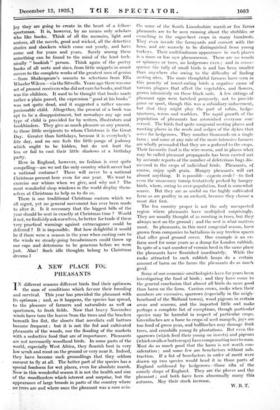A NEW PLACE FOi: PHEASANTS N different seasons different birds
find their optimum.
the sum of conditions which favour their breeding and survival. This year has provided the pheasant with its optimum ; and, as it happens, the species has spread, to the pleasure of farmers and naturalists as well as sportsmen, to fresh fields. Now that heavy November winds have torn the leaves from the trees and the bracken beneath lies flat, the shoots that novelists call battues become frequent ; but it is not the fed and cultivated pheasants of the woods, nor the flooding of the markets with a seductive food that are of importance. Pheasants are not necessarily woodland birds. In some parts of the world, especially West Africa, they flourish best in very low scrub and roost on the ground or very near it. Indeed, they have become such groundhogs that they seldom consent to fly at all. The better part of the species has a special fondness for wet places, even for absolute marsh. Now in this wonderful season it is not the health and size of the woodlanders which interest and surprise, but the appearance of large broods in parts of the country where no trees are and where once the pheasant was a ram ovis. On sonic of the South Lincolnshire marsh or fen farms pheasants are to be seen running about the stubbles or crouching in the sugar-beet crops in many hundreds. They even invade the farmyards and consort with the hens, and are scarcely to be distinguished from young turkeys. Their multitudinous appearance in such places is a more or less new phenomenon. There are no woods or spinneys or trees, no hedgerows even ; and in conse- quence the tally of small birds is and has been smaller than anywhere else owing to the difficulty of finding nesting sites. The more thoughtful farmers have seen in this paucity of insect-eating birds a negative cause of various plagues that affect the vegetables, and flowers, grown intensively on these black soils. A few sittings of pheasant eggs were hatched purposely, not to provide game or sport, though this was asubsidiary inducement, but that they might play the part of robin, hedge- sparrows, wrens and warblers. The rapid growth of the population of pheasants has astonished everyone con- cerned. The birds find quite congenial nesting places and roosting places in the reeds and sedges of the dykes that serve for hedgerows. They number thousands on a single farm ; and some at any rate of the more intensive farmers are wholly persuaded that they are a godsend to the crops. Their favourite food is the wire-worm, and in places what may be called pheasant propaganda has been carried out by accurate reports of the number of deleterious bugs dis- covered in the crops of individual birds. Pheasants, of course, enjoy spilt grain. Hungry pheasants will cat almost anything. It is possible—experto erede /—to find even the unsavoury turnip tentatively pecked by hungry birds, where, owing to over-population, food is somewhat scarce. But they are as useful on the highly cultivated farm as are poultry in an orchard, because they choose a meat diet first.
The fen country proper is not the only unexpected region where pheasants have multiplied surprisingly. They are usually thought of as roosting in trees, but they always nest on the ground ; and the nest is what matters most. So pheasants, in this most congenial season, have grown from companies to battalions in any treeless spaces that offer good ground cover. One example is an ex- farm used for some years as a dump for London rubbish. In spite of a vast number of vermin bred in the same place the pheasants have flourished inordinately. While the rooks attracted to such rubbish heaps do a certain amount of harm on the farms the pheasants do as much good.
Some of our economic ornithologists have for years been investigating the food of birds ; and they have come to the general conclusion that almost all birds do more good than harm on the farm. Carrion crows, rooks when their numbers are excessive, sparrows (especially in the neigh- bourhood of the Midland towns), wood pigeons in certain areas and seasons, and the imported little owl make perhaps a complete list of exceptions, though particular species may be harmful in respect of particular crops.
Greenfinches are a bane to crops of seed mange's, jays are too fond of green peas, and bullfinches may damage fruit trees, and crossbills young fir plantations. But even the sparrows (which feed their young on insects) and pigeons (which swallow buttercups) have compensating uses to man. Most do so much good that the harm is not worth con- sideration ; and some few are benefactors without sub. traction. If a list of benefactors in order of merit were drawn up two species would head it in those parts of i✓ngland unblessed by hedgerows—those ribs of the comely shape of England. They are the plover and the pheasant ; and both have been abnormally many this autumn. May their stock increase.
W. B. T.






















































 Previous page
Previous page